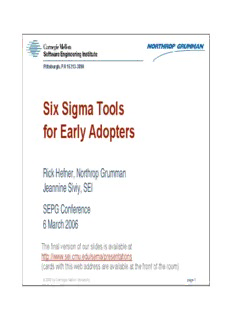
Six Sigma Tools for Early Adopters - Software Engineering Institute PDF
Preview Six Sigma Tools for Early Adopters - Software Engineering Institute
Pittsburgh, PA 15213-3890 Six Sigma Tools for Early Adopters Rick Hefner, Northrop Grumman Jeannine Siviy, SEI SEPG Conference 6 March 2006 The final version of our slides is available at http://www.sei.cmu.edu/sema/presentations (cards with this web address are available at the front of the room) ©2006 by Carnegie Mellon University page 1 Background Six Sigma has proven to be a powerful enabler for process improvement • CMMI adoption • Process improvement for measurable ROI • Statistical analysis This tutorial is about gleaning value from the Six Sigma world, to raise the caliber of engineering, regardless of the corporate stance on Six Sigma ©2006 by Carnegie Mellon University page 2 Agenda Six Sigma Benefits for Early Adopters – What the Books Don’t Tell You The 7 Six Sigma Tools Everyone Can Use I Hear Voices Dirty Data (and How to Fix It) Statistical Process Control – Where Does It Apply to Engineering? Convincing Senior Management: The Value Proposition Summary Cheap Sources of Information and Tools MSE Addendum ©2006 by Carnegie Mellon University page 3 What is Six Sigma? Six Sigma is a management philosophy based on meeting business objectives by reducing variation • A disciplined, data-driven methodology for decision making and process improvement To increase process performance, you have to decrease variation Too early Too late Tooearly Too late Greater predictability in the process Defects Defects Less waste and rework, which lowers costs Reduce variation Delivery Time Products and services Delivery Time that perform better Spread of variation Spread of variation and last longer too wide compared narrow compared to Happier customers to specifications specifications ©2006 by Carnegie Mellon University page 4 A General Purpose Problem-Solving Methodology: DMAIC Problem or goal statement (Y) Define Measure Analyze Improve Control • Refine problem & goal • An improvement journey to achieve goals and resolve statements. problems by discovering and understanding • Define project scope & relationships between process inputs and outputs, boundaries. such as Y = f(defect profile, yield) = f(review rate, method, complexity……) ©2006 by Carnegie Mellon University page 5 DMAIC Roadmap Define Measure Analyze Improve Control Define Identify Explore Identify Define project needed data possible control scope data solutions method Characterize Establish Obtain Select Implement formal data set process & solution problem project Document Evaluate Implement data quality Update (pilot as improvement needed) project scope Summarize & scale & baseline Evaluate data [Hallowell-Siviy 05] Phase Exit Review ©2006 by Carnegie Mellon University page 6 Toolkit Define Measure Analyze Improve Control GQIM and Cause & Effect Design of Statistical Benchmark Indicator Diagrams/ Experiments Controls: Contract/Charter Matrix Templates • Control Modeling Kano Model Failure Modes & Charts Data Collection ANOVA Voice of the Effects Analysis • Time Series Methods Customer Tolerancing methods Statistical Measurement Voice of the Inference Robust Design System Non-Statistical Business Reliability Analysis Evaluation Systems Controls: Quality Function Root Cause Thinking • Procedural Deployment Analysis, Decision & Risk adherence including 5 Whys Analysis • Performance Hypothesis Test Mgmt PSM Perform • Preventive Analysis Model measures 7 Basic Tools (Histogram, Scatter Plot, Run Chart, Flow Chart, Brainstorming, Pareto Chart), Control charts (for diagnostic purposes), Baseline, Process Flow Map, Project Management, “Management by Fact”, Sampling Techniques, Survey Methods, Defect Metrics ©2006 by Carnegie Mellon University page 7 Process Improvement – Design for Six Sigma (e.g., DMADV) Define Measure Analyze Design Verify Define Identify Explore Develop Evaluate project customers data detailed pilot scope design Scale-up Research Design Establish Refine design VOC solution predicted formal performance project Document Benchmark Predict performance Develop pilot Quantify CTQs ©2006 by Carnegie Mellon University page 8 Organizational Adoption: Roles & Responsibilities Champions – Facilitate the leadership, implementation, and deployment Sponsors – Provide resources Process Owners – Responsible for the processes being improved Master Black Belts – Serve as mentors for Black Belts Black Belts – Lead Six Sigma projects • Requires 4 weeks of training Green Belts – Serve on improvement teams under a Black Belt • Requires 2 weeks of training ©2006 by Carnegie Mellon University page 9 Valuable Tools for Engineers Six Sigma provides a comprehensive set of tools for: • Soliciting and understanding customer needs (requirements, delighters, perceptions of quality) • Defining and improving processes (inputs/outputs, customer/suppliers, essential/nonessential activities, capability, stability/predictability) • Understanding data (trends, relationships, variation) These tools can be used even if your organization is not implementing Six Sigma ©2006 by Carnegie Mellon University page 10
Description: